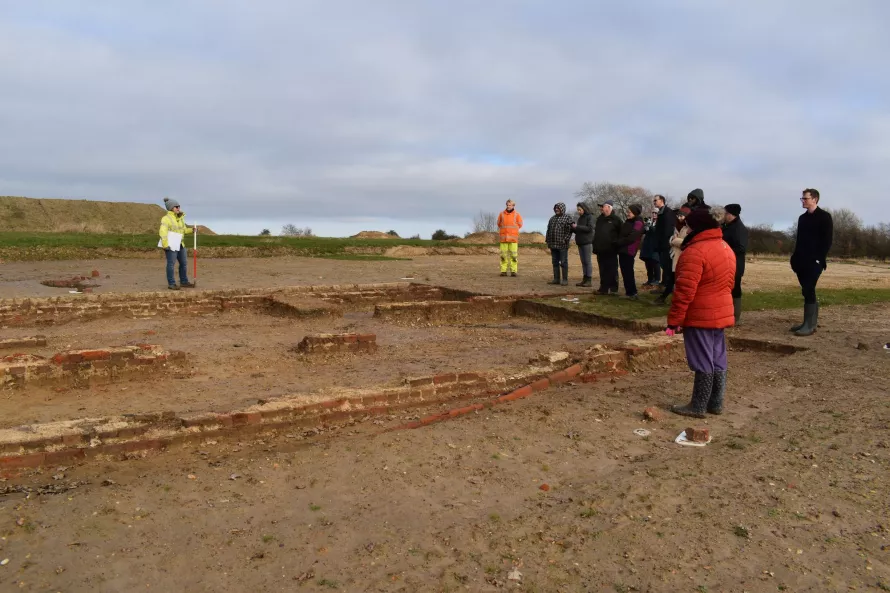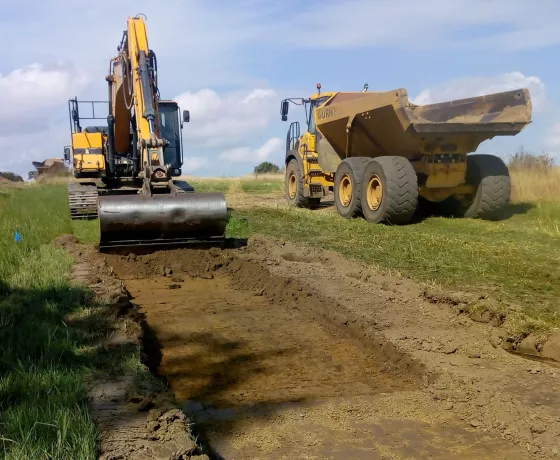Below is the full press release issued on Sunday, 6th March 2022, and covered by the following news outlets:
OA Cambridge recently completed an excavation in Essex which has revealed the remains of a military barracks occupied during the Napoleonic Wars, a period vividly brought to life in Bernard Cornwell’s fictional ‘Sharpe’ series.
At the start of the 19th century, Weeley was a small parish of 250 people. Between 1803 and 1814 the population swelled with the arrival of a military barracks to garrison the Martello towers on the Essex coast and to provide defence against French invasion. From historical sources, it appears that as many as 4,100 soldiers along with their families and 220 cavalry horses were stationed in Weeley during this time. Mary Ann Grant, wife of Captain James Grant of the 42nd Regiment of Foot (also known as the Black Watch) related her experience of living at Weeley in her diaries dating to 1803-4 as the camp was being set up. The Grants arrived to a collection of tents and unfinished roads and accommodation blocks. A watercolour painting of Weeley Barracks made by Captain Durrant (probably in 1809) seems to show a more established settlement with several building types with different coloured roofs.
However, no physical evidence of the Napoleonic barracks known to have been sited at Weeley had been found until now. With the change in fortunes of the war, the barracks became less important, and with abdication of Napoleon in 1814, it was thought redundant, and moves made to demolish it and return the land to the landowners. An advert selling the barrack furnishings was published in newspapers in 1815. The list of items for sale include bedsteads, officers’ mess tables, washing tubs, kitchen ranges and even chamber pots. As well as the contents, the bricks and tiles of the buildings were also auctioned off. Following this comprehensive demolition and 200 years of ploughing, it was doubtful whether anything had survived. There was no surface trace of the barracks, nor were any details known about its layout. Now, thanks to an excavation carried out in 2021-22, archaeologists have now identified 16 buildings, roadways, drainage systems and an array of military-related finds from Weeley Barracks.
The excavation was carried out as a planning condition ahead of the building of a residential and mixed-use development by Rose Builders. A team from Oxford Archaeology Cambridge has been working at the site over the past five months, under the management of RPS Consulting. The archaeological works was approved by the archaeological advisor to Tendring District Council (Place Services) and regularly monitored by them.
Archaeologists found a lot of variation in the standard of construction of these buildings, with the thickness of the wall foundations and quality of bricks varying across the buildings. This may indicate that more time and care was taken to finish some buildings over others, perhaps with officer quarters finished to a higher quality compared with those of the soldiers. A hierarchy of living quarters is also indicated by the number of fireplaces. Two of the largest buildings on the northern side of the site each have five fireplaces, whereas all other buildings had just the one. It seems likely that these represent officer living quarters. Mary Ann Grant mentions that she and her husband, a captain, had a single room with a fireplace.
A widespread network of French drains put in place for the Napoleonic camp were found and, incredibly, were still functioning. French drains comprise trenches dug into the ground and backfilled with tile. They are still in use today, but modern examples have a plastic pipe at the base of the trench and are backfilled with stones or gravel.
The artefacts found at Weeley Barracks give a tantalising insight into the people who were stationed at the barracks. These include a buckle plate with the name J.T Miller scored into it, as well as a press seal showing a man’s head wearing a military helmet. Fragments of fine pottery with a neoclassical design recovered from the site are likely to have come from a teapot. Louise Moan, Senior Project Manager, at Oxford Archaeology said,
“It’s not very often that we get a chance to investigate a site of this age. So it’s been really exciting unpicking the findings and being able to tie these to historical documentation so that we get an understanding of the people stationed here and what it was like living at the barracks”.
Nick Cooke, Director, Heritage at RSP Consulting, who commissioned the work on behalf of Rose Builders said,
“From the beginning it was clear that we were dealing with an unusual site. Temporary Napoleonic barracks such as Weeley have rarely been investigated archaeologically, and it was imperative that we designed a programme of works, in consultation with Place Services, which allowed us to investigate it thoroughly. The results of the excavations, combined with a programme of documentary and historic research to put the barracks in its context, will tell us much about this key moment in both local and national history.”
Despite the construction of the nineteenth century barracks, Oxford Archaeology were surprised to find far earlier remains still intact. A concentration of Iron Age (800BC to AD43) and Roman (AD43 to AD410) features were found hidden in and amongst the Napoleonic buildings. The main prehistoric feature was a large circular ditch. The ring ditch was 18m in diameter, with the ditch itself 1m wide and with an entrance on its eastern side. Unfortunately, no evidence was found to indicate what the circular ditch was used for although a large selection of pottery was recovered from the ditch dating it to the Iron Age.
The archaeological team have shared their progress with the local community throughout the excavation. A public presentation was held at Weeley Village Hall at the start of the work, shortly followed by a site-based open day during October half term 2021 and regular updates posted on a dedicated blog site. A second open day was held at the end of the excavation as well as a visit from the local primary school, and a final public presentation was given to residents during February half term to show what has been found.
Last autumn, Oxford Archaeology Cambridge and RPS Consulting worked with the Ministry of Defence to involve a group of Essex-based military veterans with associations with the regiments who were stationed at Weeley Barracks, as part of the Operation Nightingale Initiative to help rehabilitate current and former military personnel through archaeological investigations. Over a week, the group helped to excavate the brick foundations of the most well-preserved building located at the site. Richard Osgood, Lead archaeologist on Operation Nightingale said,
“I was delighted that some of the Operation Nightingale veterans were able to participate in this important excavation. It highlighted that archaeology doesn’t have to be especially old, and that the past belongs to everyone – it is, after all, about people. The fact that the site linked directly to some of the forebear Regiments of our participants was poignant for all”.
Now that the excavations have come to an end, the finds are being processed at Oxford Archaeology's office in Bar Hill, Cambridgeshire, before being sent to specialists to identify and make recommendations for further analysis, before a full report is written. This will be checked by Place Services and submitted to the county’s Historic Environment Record. The records and finds will be deposited with an appropriate registered archive facility, as required by Place Services, to be accessible to researchers and the public. Adrian Gascoyne, Head of Place Services, said,
“Place Services were delighted to act as archaeological advisors on this exciting project which has contributed greatly to our understanding of this important period of our history. It is fantastic to discover such high- quality finds, many of which will be available in the future for the public to see and enjoy.”
Other posts in this collection
Read our latest posts about the archaeological investigations at Weeley.



